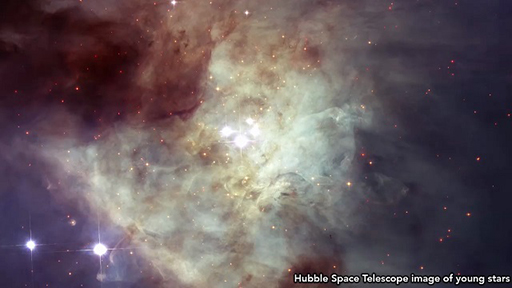2.1 The Universe
This video provides a brief history of the Universe and gives details of its age and size today. The questions that follow will help you discover the time and space scales that correspond to the biggest and oldest objects in the size–time explorer. First you will look at describing the age and size of the Universe in SI units, and then consider how quickly some of the early occurrences in the Universe took place.
While watching the video, record the following information to use in the questions that follow:
- the age of the Universe today
- the diameter of the Universe today (in metres)
- the times that events occurred since the big bang.

Transcript: Origins of the Universe
Question 1
Question 2
Question 3
Use your notes from the video to identify which of the following two tables correctly describes the events and temperatures that occurred after the big bang:
| Event | Temperature/K | Time since big bang/s |
|---|---|---|
| big bang | unknown | 0 |
| neutrons and protons formed | ~100 000 | 10−6 |
| quarks exist in a plasma | 100 000 000 000 | 10−12 |
| quarks and other fundamental particles form stable particles | 10 000 000 000 000 | 10–1000 |
| today | 2.7 | × 1017 |
| Event | Temperature/K | Time since big bang/s |
|---|---|---|
| big bang | unknown | 0 |
| quarks exist in a plasma | 10 000 000 000 000 | 10−12 |
| quarks and other fundamental particles form stable particles | 100 000 000 000 | 10−6 |
| neutrons and protons formed | ~100 000 | 10–1000 |
| today | 2.7 | × 1017 |
Answer
Table 3B is correct. It shows the correct combination of events, temperatures and times, with the universe cooling over time, and the times listed in a logical order.
Question 4
Use the information from Question 3 to consolidate your learning and fill in the missing gaps in the paragraph below.
Summary
Here, you learned about the current size of the Universe and its age, as well as it origin by working backward through time. The Universe is the biggest thing known, but considering how it began requires you to think about some of the very smallest things known, including subatomic particles such as protons and neutrons.
Next: That’s as big as possible! Now return to the size–time explorer [Tip: hold Ctrl and click a link to open it in a new tab. (Hide tip)] to choose your next level of scale, or use the ‘Next >’ button to go to the next level down on the size scale.
